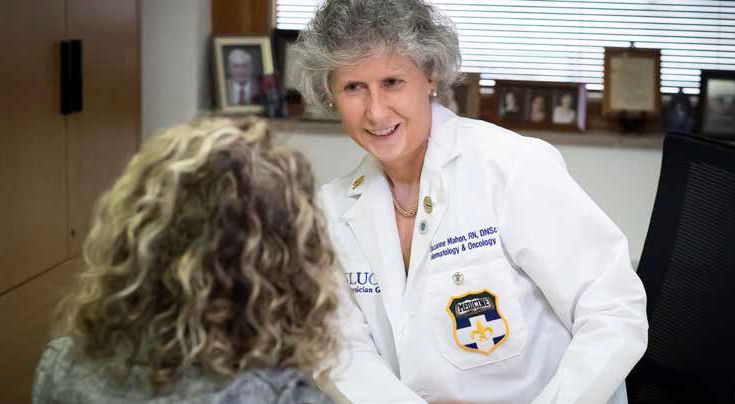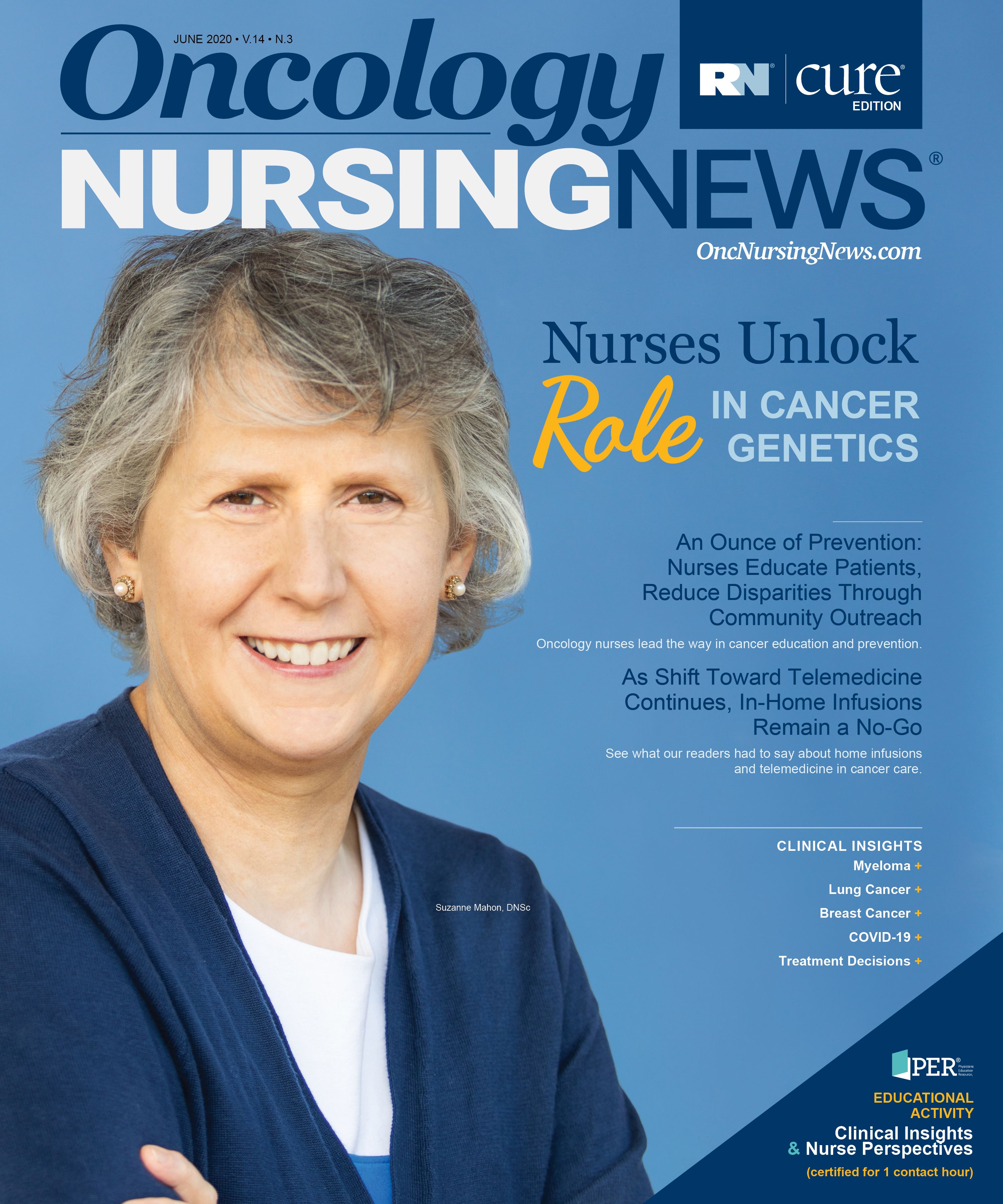Nurses Unlock Role in Cancer Genetics
As genetics in cancer care grows, so will the role of the oncology nurse.

Photo Courtesy of SLUCare
In her role as a genetic professional, Suzanne Mahon, DNSc, a clinical nurse specialist at SLUCare physician group in St Louis, Missouri, recently met with a 46-year-old single mother who had been diagnosed with metastatic triple-positive breast cancer and referred for genetic counseling and testing.
The woman had marketplace insurance and was denied coverage for genetic testing, but Mahon worked with the testing laboratory. Together with other compassionate care resources, the cost of testing was able to be covered. Testing revealed a CHEK2 mutation, a germline mutation that has been linked with up to a 37% lifetime risk for breast cancer.1
“This information will guide her treatment decisions regarding use of bilateral mastectomies, as well as her long-term follow-up, such as more frequent colon, gynecologic, and thyroid screening,” Mahon said.
The patient had a 22-year-old daughter who was also concerned about her risk and sought genetic counseling. After 2 counseling sessions, the daughter decided to proceed with genetic counseling; however, she was uninsured. Again, compassionate care funding was used to cover the cost of her testing, which revealed she was negative for the CHEK2 mutation and at average risk for developing cancer. Now, Mahon said, the daughter can focus on her studies and caring for her mother.
GENETIC CANCERS
Inherited genetic mutations play a role in between 5% to 10% of all cancers, according to the National Cancer Institute.2 Specific genetic mutations have now been associated with more than 50 hereditary cancer syndromes. The National Comprehensive Cancer Center (NCCN) offers guidelines on genetic testing organized by both disease and syndrome type.
More generally, though, nurses can look for several characteristics or situations that might point to genetic or familial high-risk situations, according to Mahon.
The first, and often easiest to spot, is the diagnosis of a cancer in a young person that typically occurs at an older age. For example, the diagnosis of breast or colon cancer at age 50 or younger. “Cancers that we usually see in 60- or 70 year-olds occurring in younger patients, that is always a red flag,” Mahon said.
Another group of people often flagged for possible genetic testing are those diagnosed with very rare tumors, such as male breast cancer, paragangliomas, or medullary thyroid cancer.
Specific characteristics of a cancer diagnosis might also point to the need for genetic testing. For example, people with colon cancers that show high microsatellite instability (MSI-high),3 a patient with more than 15 or 20 colon polyps in a lifetime, or a patient with a lot of atypical moles.
“These are not necessary malignant conditions, but when they occur they often can be the beginning of something or an indicator that something else is going on,” Mahon said.
Any or all of these factors might point to the need for genetic testing, and that is before even diving into a patient’s family history.
“This is the very first thing that nurses on the front line take in every type of medical practice,” said Wendy Brouwer, NP, of The University of Texas MD Anderson Cancer Center in Houston, who deals mostly with hereditary breast and ovarian cancers.
For example, the NCCN guidelines for high-penetrance breast cancers call for genetic testing among women aged 45 to 50 with one or more blood relatives with any breast, ovarian, or pancreatic high-grade prostate cancer. Testing is also indicated in those diagnosed at any age with one or more blood relatives diagnosed with breast cancer at age 50 or younger, or ovarian, pancreatic, or prostate cancer at any age, and in anyone with 3 or more breast cancer diagnoses in close blood relatives.4 (see sidebar) “These things do not always mean there is a mutation there, but it does mean that if there is one we don’t want to miss it,” Brouwer said.
PRACTICAL ADVICE
Undergoing testing to look for genetic risk for cancer can be difficult, but there are ways in which nurses can help guide patients through the process.
One of the most important things to emphasize, according to Mahon, is that counseling is not testing.
“Counseling means that you are coming in to learn about your options,” she said. “We emphasize that the counseling appointment is not where testing is done.”
Mahon has seen a wide variety of outcomes after genetic counseling. Some patients who were intent on getting testing done decide to delay after exploring their options. Others who were set against testing learn more and ask for tests to be done immediately.
It is also important for nurses not to trivialize testing and what it could mean to the patient and their families. Explain that it is OK for them to be scared. It is ok for them to be hesitant. Those feelings are normal.
Nurses can also encourage patients to bring another family member to the genetic counseling and testing appointments. Sometimes dealing with a cancer diagnosis and the burden of having to share information about familial risk can be too much for the patient alone to take on, Mahon said.
Finally, Brouwer said, patients may respond to the information that the results of their genetic testing could not only affect treatment decisions for their care, but could help increase prevention of future cancers in themselves and their family members.
ACTIONABLE MUTATIONS
Mahon said that she will not conduct genetic testing for any mutations that are not considered “actionable,” meaning knowledge about the mutation can affect treatment decisions or future cancer prevention.
Women who have BRCA 1/2 mutations and are diagnosed with breast or ovarian cancer may qualify for treatment with PARP inhibitors.
Patients with Lynch syndrome, an inherited cancer syndrome associated with increased risk for colon and other cancers, tend to have higher rates of MSI-high tumors, which may respond to immunotherapy with pembrolizumab.5
For prevention, knowledge of a BRCA 1/2 mutation in breast cancer can affect decisions made about choice of breast surgery, for example. Women with these mutations have a higher risk for a second breast cancer and may opt to undergo bilateral mastectomy rather than lumpectomy.
Genetic testing for Lynch syndrome could encourage people to undergo increased screening for colon cancer, endometrial cancer, ovarian cancer, and more. People found to have a genetic mutation for medullary thyroid cancer can encourage family members to undergo screening, as there is a nearly 100% lifetime risk for developing malignancy associated with these mtuations.6
“Where you are really getting into some conundrums are testing in some hematologic malignancies,” Mahon said. “Identification of genetic mutations [is] not really actionable for family members, but [is] important to know if you need to select possible transplant donors.”
Nurses will play an important role in guiding patients through their testing results, and discussing sharing any positive results with family members.
“The HIPAA rules prohibit me from calling these family members,” Mahon said. “All I can do is tell the patient, ‘These are the family members at increased risk.’ [For] people with the greatest risk, like siblings and offspring, we make the biggest deal about offering the option of testing.”
HOPE FOR THE FUTURE
Looking to the future, Mahon said she hopes to begin to see more oncology nurses specializing in genetic counseling.
“I do this and only this all day long,” Mahon said. “We have to have more training programs for nurses to learn this and devote their practice to it. That would allow for more excellent care for families across the board.”
Brouwer said she hopes that a focus on genetics spreads even further than just among oncology nurses. She belongs to the International Society of Nurses in Genetics (ISONG), a global nursing specialty organization dedicated to genomic health care, education, research, and scholarship.
“This organization represents a really up-and-coming field,” Brouwer said. “Oncology nurses are on the second line, when cancers have already started to happen. If nurses can all start to have a lot more knowledge about genetics, enough to pick up on risk in family history, we can start to play more of a role in the prevention side of things.”
References
1. Weischer M, Bojesen SE, Ellervik C, Tybjaerg-Hansen A, Nordestgaard BG. CHEK2*1100delC genotyping for clinical assessment of breast cancer risk: meta-analyses of 26,000 patient cases and 27,000 controls. J Clin Oncol. 2008;26(4):542-548. doi:10.1200/JCO.2007.12.5922
2. The Genetics of Cancer. National Cancer Institute. Updated October 12, 2017. Accessed May 4, 2020. https://www.cancer.gov/about-cancer/causes-prevention/genetics
3. Genetic Testing, Screening, and Prevention for People with a Strong Family History of Colorectal Cancer. American Cancer Society. Updated February 21, 2018. Accessed May 4, 2020. https://www.cancer.org/cancer/colon-rectal-cancer/causes-risks-prevention/genetic-tests-screening-prevention.html
4. NCCN. Clinical Practice Guidelines in Oncology. Genetic/Familial High-Risk Assessment: Breast, Ovarian, and Pancreatic, version 1.2020. Accessed May 4, 2020. https://www.nccn.org/professionals/physician_gls/pdf/genetics_bop.pdf
5. Yurgelun MB, Hampel H. Recent advances in Lynch Syndrome: diagnosis, treatment, and cancer prevention. Am Soc Clin Oncol Educ Book. 2018;38:101-109. doi:10.1200/EDBK_208341
6. Roy M, Chen H, Sippel RS. Current understanding and management of medullary thyroid cancer. Oncologist. 2013;18(10):1093-1100. doi:10.1634/theoncologist.2013-0053

Innovative Program Reduces Nurse Turnover and Fosters Development
Published: September 12th 2024 | Updated: September 12th 2024The US Oncology Network (The Network) has developed one of the most comprehensive programs in the nation to support the professional development and retention of new oncology nurses.


